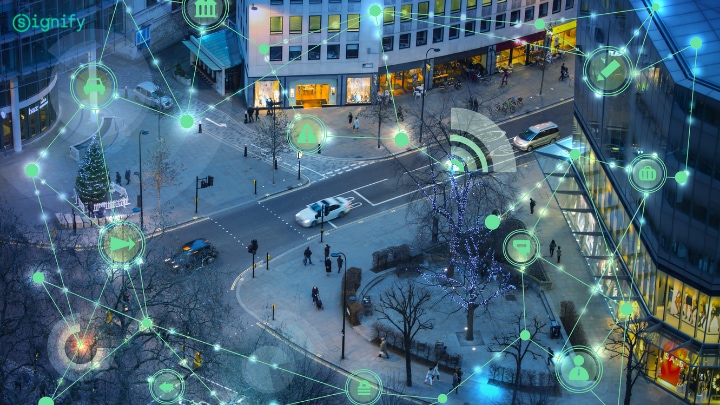Chicago and Mesa, Ariz., are two cities that recently made the move to smart LED streetlights, attaining the illumination and energy benefits, as well as an improved community experience.
PROJECTS | Smart city technology enriches community experience and safety
July 28, 2023
Streetlights reveal the urban form by night and bring a city’s skyline to life. Essential for safety and wayfinding, these fixtures consume a considerable amount of energy — they often are cities’ greatest or second greatest energy load, accounting for 25% to 50% of municipal energy bills. As a result, cities and towns nationwide have committed to retrofitting streetlights and other exterior fixtures with LEDs equipped with advanced controls, allowing them to monitor for maintenance, energy usage, and output.
Cities’ go-to streetlamps have long been high-pressure sodium (HPS) or metal halide, but LEDs present numerous benefits over these conventional lamp types. Not only do LED fixtures consume up to 75% less energy than HPS fixtures, but they also lower operation and maintenance costs.
- High-quality light combined with camera systems can also help with police surveillance.
Connectivity in a desert community
After moving toward becoming a smart city for the past several years, the city of Mesa, Ariz., population 500,000, engaged Signify to conduct a lighting retrofit of its existing streetlight infrastructure and transform it into a platform for broadband connectivity. Utilizing Signify’s BrightSites technology, the city replaced existing light fixtures to support public Wi-Fi and CCTV cameras.
- System components include a digital smart hub, broadband luminaires, and smart poles.
- Smart poles provide broadband connectivity and a 4G/5G and Wi-Fi infrastructure, serving as a platform for various IoT applications, including cameras for certain streetlights, all within a cleanly packaged aesthetic.
- Each pole was replaced from the ground up, including the streetlight heads.
- Interact City Nodes — luminaire-based control devices that connect streetlights to the Interact City LMS using cellular technology — manage, monitor, and control each streetlight individually.
- This involves ongoing collaboration with the community to determine where citizens want enhanced safety.
- Cameras are also utilized in parking lots and along streets with parking to analyze congestion, which is then pushed to an app available to community members who might use it to determine the best place to park when attending an event, for example.
Community engagement has been key to the success of Mesa’s smart lighting project from the outset.
According to Harry Meier, the city’s deputy CIO for Innovation, city officials conducted public town halls in many neighborhoods to share the benefits of converting to LEDs and to listen to residents’ preferences. . ."
Continue reading > LEDs Magazine
RELATED








No comments:
Post a Comment